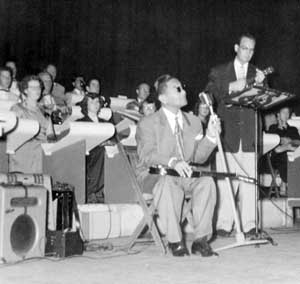On the evening of Monday, September 28, 1953, Sol Hoopii (1902-1953), "King of the Hawaiian Steel Guitar," is the star attraction in a fateful concert at the Moore Theatre in downtown Seattle. Born Solomon Ho'opi'i Ka'ai'ai in Honolulu, he started playing the ukulele and then Spanish-style acoustic guitar as a small child. By the time he was a teenager, he began to master the Hawaiian style of "steel guitar" in which the musician holds the guitar face-up on his lap and picks the strings with one hand while using the other to slide a metal bar up and down the neck, creating the keening, and now highly identifiable, "island music" sound. Hoopii moved to Hollywood and quickly became perhaps the most famous Hawaiian musician of his time, before settling in Seattle in the late 1940s. By mid-1953, although he has continued to perform regularly, Hoopii is seriously ill with diabetes, and the concert at the Moore will prove to be his last appearance on stage.
From Hollywood to Seattle
Sol Hoopii -- (pronounced sawhl ho-ohh-pee-eee), the simplified stage version of his name that he adopted soon after moving to the mainland -- and a few pals came by ocean liner to San Francisco in 1919. By 1922 Hoopii's musical skills were attracting attention in the Hollywood entertainment industry. He joined a band, began making radio appearances, formed his own trio, won a following, made his recording debut in 1925, and was soon seen in a number of early movies. Hoopii's reputation as a master guitarist saw him recruited to perform on recordings with superstar entertainers, including Spokane's Bing Crosby (1903-1977), and the "Hollywood Hawaiian" soon had various instrument manufacturers anxious to get his endorsement and have their guitars seen in his hands.
Moving up to recording deals with Columbia Records (in 1926), Brunswick Records (in 1933), and then Decca Records (in 1938), Hoopii also gigged and toured constantly. Perhaps exhausted by the rigors of the ever-demanding music biz, Hoopii discovered a new calming influence in life: He became a Christian and devoted his remaining days to playing sacred hymns and performing at churches far and wide. It was while touring through the Northwest in 1942 that Hoopii met Seattle's most prominent steel guitarist, Paul H. Tutmarc Sr. (1896-1972). Tutmarc was also a music teacher, radio performer, shopkeeper, and the man behind the 1930s Audiovox brand of electric musical instruments. The two hit it off instantly. Hoopii accepted an invitation to jam on some songs at the Tutmarc family's Maple Leaf neighborhood home at 8217 8th Avenue NE, and a long-term friendship ensued.
The Tutmarc family was very committed to the Christian faith and Tutmarc's son, Paul "Bud" Tutmarc (1924-2006) -- another steel guitarist -- was a dedicated member of the Calvary Temple at 6801 Roosevelt Way NE, where for many years he led the youth choir and organized countless public concerts around town. As Bud's friendship with Hoopii grew, so too did their collaboration through such musical events. Bud knew how to book and promote shows, and Hoopii became a solid attraction, playing gospel songs on his 1938 Rickenbacker Model B6 lap steel guitar while Bud led the backing band, playing upright bass, ukulele, and/or steel guitar, sometimes playing steel duets with the star.
Throughout the 1940s Hoopii and his first wife, Georgia Stiffler, maintained a home in Los Angeles, and he often stayed with the Tutmarcs when working the Northwest circuit. Eventually, however, they separated, Hoopii married Seattle resident Anna Eleanor Hutchinson (1913-2003), and they bought a home in Northwest Seattle. During his years in Seattle, Hoopii would play countless local shows, some with a religious orientation and others with a "Night in Hawaii" theme.
The Final Concert
Built circa 1907, Seattle's fabled Moore Theatre at 1932 2nd Avenue was, and remains, a glorious 1,400-capacity concert venue. Bud Tutmarc aimed high for the September 28, 1953, concert featuring Sol Hoopii, renting the huge theater and making arrangements to have his full orchestra and choir back the musical star. All this, despite concerns that Hoopii's health was quickly fading. The guitarist had been suffering from diabetes and his wife and friends were all aware that his eyesight was failing. Still, on the night of the concert, Tutmarc was taken aback when he realized the level deterioration that had recently occurred: his sunglasses-bedecked friend now required help getting from backstage out to his onstage chair. The show went on, and the music was splendid, but Hoopii never felt well again.
Despite his physical ailments Hoopii happily agreed to another concert -- this one to be held at an even larger venue, the Civic Auditorium at 225 Mercer Way, on November 16. But as that date approached, Tutmarc sadly realized that his old friend wouldn't be able to participate. On November 9, Hoopii was admitted to Seattle's Virginia Mason Hospital, and Tutmarc quickly made the necessary arrangements to have the concert broadcast via a closed-circuit radio so that his ailing friend would at least be able to listen to the performance while resting in his room.
Alas, that wasn't to be. Mere hours before the November 16 concert commenced, Solomon Ho'opi'i Ka'ai'ai died at age 51. Tutmarc stoically carried on with the show in his honor. A funeral service was held at the Tutmarc family's church, Calvary Temple, on November 19, 1953, and then the following week there was a memorial event at the Masonic Temple at Harvard Avenue E and E Pine Street, with Hoopii's beloved 1938 Rickenbacker guitar displayed in repose on a stand at center stage. Sol Hoopii was later buried at Forest Lawn Memorial Park in Hollywood Hills, California.

